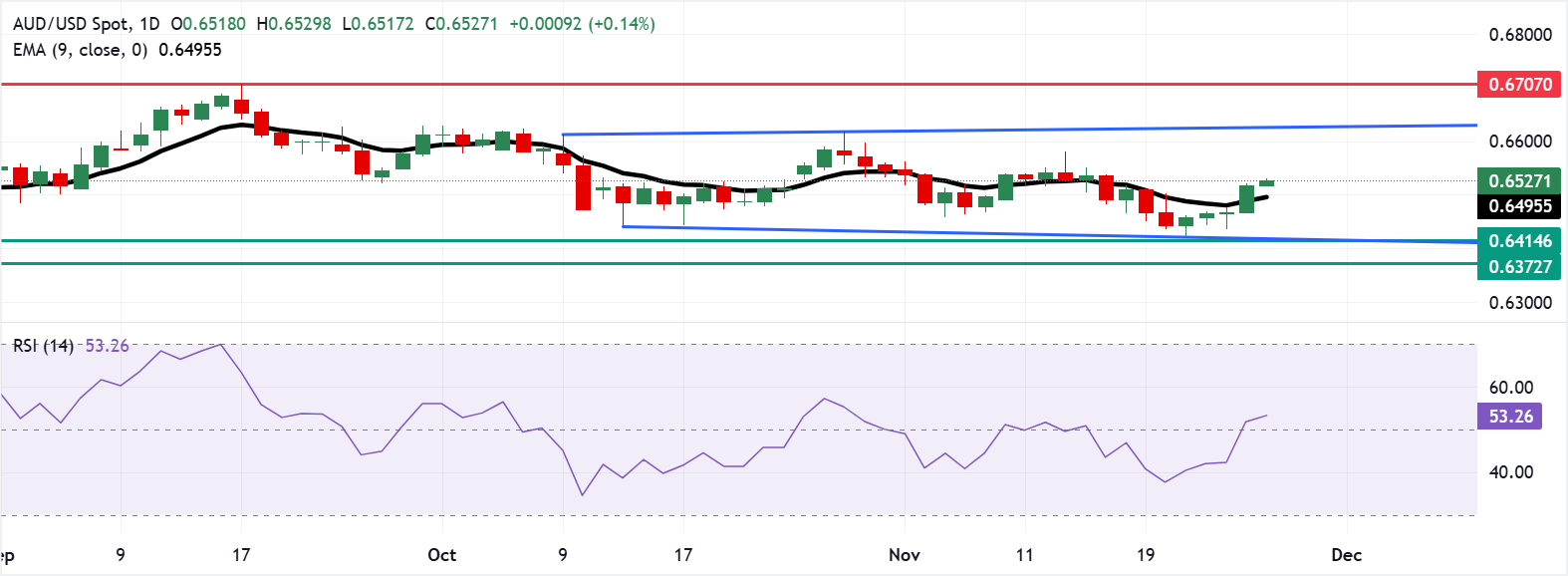Australian Dollar extends gains as traders expect RBA to hold rates

- The Australian Dollar remains stronger as Private Capital Expenditure rose by 6.4% QoQ in Q3.
- The AUD also strengthened after the latest monthly CPI release added to the RBA's cautious sentiment.
- The US Dollar extends losses amid rising odds of a Fed rate cut in December.
The Australian Dollar (AUD) gains against the US Dollar (USD) on Thursday, extending its gains for the fifth successive session. The AUD/USD pair gains ground as the US Dollar (USD) struggles amid rising odds of Federal Reserve (Fed) rate cut bets in December.
The Australian Bureau of Statistics (ABS) released Private Capital Expenditure on Thursday, which rose by 6.4% quarter-over-quarter in the third quarter, accelerating from a 0.2% gain in Q2 and surpassing the 0.5% expected. On Wednesday, ABS reported the first “complete” monthly Consumer Price Index (CPI), which climbed by 3.8% year-over-year (YoY) in October. The reading surpassed the market consensus of a 3.6% rise and a 3.5% increase prior.
The AUD gained ground after the first monthly CPI boosted the cautious sentiment surrounding the Reserve Bank of Australia (RBA) policy outlook. The RBA is expected to maintain the Official Cash Rate (OCR) at 3.6% in December as inflation remains above RBA’s 2–3% target range. RBA officials noted that the unemployment rate has risen slightly, but the job market remains healthy and is expected to continue doing so.
The ASX 30-Day Interbank Cash Rate Futures showed, as of November 26, the December 2025 contract trading at 96.41, implying a 6% chance that the RBA will cut the cash rate to 3.35% from 3.60% at its upcoming Board meeting.
US Dollar declines amid increasing Fed rate cut bets
- The US Dollar Index (DXY), which measures the value of the US Dollar against six major currencies, is losing ground and trading around 99.50 at the time of writing. The Greenback extended its losses amid reinforcing expectations of a more accommodative policy stance, driven by reports that the White House has narrowed its search for the next Fed chair to National Economic Council Director Kevin Hassett. Investors see Hassett as supportive of US President Donald Trump’s preference for lower interest rates.
- The CME FedWatch Tool suggests that markets are now pricing in a more than 84% chance that the Fed will cut its benchmark overnight borrowing rate by 25 basis points (bps) at its December meeting, up from the 30% probability that markets priced a week ago.
- The US Department of Labor (DOL) reported on Wednesday that Initial Jobless Claims fell to 216,000 for the week ending November 22, down 6,000 from the previous week’s revised figure. The result was stronger than the market expectation of 225,000. Meanwhile, the 4-week moving average eased by 1,000 to 223,750.
- The US Producer Price Index (PPI) remained steady at 2.7% year-over-year in September, matching expectations and August’s reading and suggesting that inflationary pressures have stabilized. Core PPI eased to 2.6% from 2.9%, undershooting the forecast of 2.7%.
- The US Retail Sales rose by 0.2% month-over-month (MoM) in September, slowing from the 0.6% increase seen in August, indicating more cautious consumer spending. Separately, the Conference Board reported a sharp deterioration in household sentiment, with Consumer Confidence sliding 6.8 points to 88.7 in November from 95.5 in October.
- Fed Governor Christopher Waller told Fox Business on Monday that his primary concern is the weakening labour market, adding that inflation is “not a big problem” given the recent softness in employment. He also said the September payrolls figure will likely be revised lower and warned that concentrated hiring is “not a good sign,” indicating his support for a near-term rate cut.
- New York Fed President John Williams said on Friday that policymakers could still cut rates in the “near-term,” a remark that lifted market odds for a December move. Moreover, Fed Governor Stephen Miran said that Nonfarm Payrolls data support a December rate cut, adding that if his vote were decisive, he “would vote for a 25-bps cut.”
- The preliminary reading of Australia's S&P Global Manufacturing Purchasing Managers Index (PMI) came in at 51.6 in November, versus 49.7 prior. Meanwhile, Services PMI rose to 52.7 in November from the previous reading of 52.5, while the Composite PMI increased to 52.6 in November versus 52.1 prior.
- The Reserve Bank of Australia published the Minutes of its November monetary policy meeting last week, indicating that board members signalled a more balanced policy stance, adding that it could keep the cash rate unchanged for longer if incoming data proves stronger than expected.
- RBA Assistant Governor Sarah Hunter noted last week that “sustained above-trend growth could fuel inflationary pressures.” Hunter noted that monthly inflation data can be volatile and that the central bank won’t react to a single month of figures. She added that the RBA is closely assessing labour-market conditions to gauge supply capacity and is examining how the effects of monetary policy may be changing over time.
Australian Dollar eyes 0.6600 barrier after breaking above nine-day EMA
The AUD/USD pair is trading around 0.6530 on Thursday. The daily chart analysis shows the pair holding within a rectangular consolidation zone, signaling a neutral bias. The pair has moved above the nine-day Exponential Moving Average (EMA), highlighting that short-term upward momentum has turned stronger.
The AUD/USD pair may explore the region around the rectangle’s upper boundary near 0.6630.
On the downside, the AUD/USD pair could retreat toward the psychological level of 0.6500, aligned with the nine-day EMA at 0.6495. A break below this confluence support area could prompt the AUD/USD pair to test the lower boundary of the rectangle around 0.6420, followed by the five-month low of 0.6414, recorded on August 21.

Australian Dollar Price Today
The table below shows the percentage change of Australian Dollar (AUD) against listed major currencies today. Australian Dollar was the strongest against the US Dollar.
| USD | EUR | GBP | JPY | CAD | AUD | NZD | CHF | |
|---|---|---|---|---|---|---|---|---|
| USD | -0.10% | -0.13% | -0.20% | -0.03% | -0.13% | -0.33% | -0.14% | |
| EUR | 0.10% | -0.02% | -0.09% | 0.07% | -0.02% | -0.23% | -0.03% | |
| GBP | 0.13% | 0.02% | -0.08% | 0.10% | -0.00% | -0.21% | -0.01% | |
| JPY | 0.20% | 0.09% | 0.08% | 0.14% | 0.06% | -0.18% | 0.05% | |
| CAD | 0.03% | -0.07% | -0.10% | -0.14% | -0.08% | -0.28% | -0.11% | |
| AUD | 0.13% | 0.02% | 0.00% | -0.06% | 0.08% | -0.20% | -0.01% | |
| NZD | 0.33% | 0.23% | 0.21% | 0.18% | 0.28% | 0.20% | 0.19% | |
| CHF | 0.14% | 0.03% | 0.01% | -0.05% | 0.11% | 0.00% | -0.19% |
The heat map shows percentage changes of major currencies against each other. The base currency is picked from the left column, while the quote currency is picked from the top row. For example, if you pick the Australian Dollar from the left column and move along the horizontal line to the US Dollar, the percentage change displayed in the box will represent AUD (base)/USD (quote).
Australian Dollar FAQs
One of the most significant factors for the Australian Dollar (AUD) is the level of interest rates set by the Reserve Bank of Australia (RBA). Because Australia is a resource-rich country another key driver is the price of its biggest export, Iron Ore. The health of the Chinese economy, its largest trading partner, is a factor, as well as inflation in Australia, its growth rate and Trade Balance. Market sentiment – whether investors are taking on more risky assets (risk-on) or seeking safe-havens (risk-off) – is also a factor, with risk-on positive for AUD.
The Reserve Bank of Australia (RBA) influences the Australian Dollar (AUD) by setting the level of interest rates that Australian banks can lend to each other. This influences the level of interest rates in the economy as a whole. The main goal of the RBA is to maintain a stable inflation rate of 2-3% by adjusting interest rates up or down. Relatively high interest rates compared to other major central banks support the AUD, and the opposite for relatively low. The RBA can also use quantitative easing and tightening to influence credit conditions, with the former AUD-negative and the latter AUD-positive.
China is Australia’s largest trading partner so the health of the Chinese economy is a major influence on the value of the Australian Dollar (AUD). When the Chinese economy is doing well it purchases more raw materials, goods and services from Australia, lifting demand for the AUD, and pushing up its value. The opposite is the case when the Chinese economy is not growing as fast as expected. Positive or negative surprises in Chinese growth data, therefore, often have a direct impact on the Australian Dollar and its pairs.
Iron Ore is Australia’s largest export, accounting for $118 billion a year according to data from 2021, with China as its primary destination. The price of Iron Ore, therefore, can be a driver of the Australian Dollar. Generally, if the price of Iron Ore rises, AUD also goes up, as aggregate demand for the currency increases. The opposite is the case if the price of Iron Ore falls. Higher Iron Ore prices also tend to result in a greater likelihood of a positive Trade Balance for Australia, which is also positive of the AUD.
The Trade Balance, which is the difference between what a country earns from its exports versus what it pays for its imports, is another factor that can influence the value of the Australian Dollar. If Australia produces highly sought after exports, then its currency will gain in value purely from the surplus demand created from foreign buyers seeking to purchase its exports versus what it spends to purchase imports. Therefore, a positive net Trade Balance strengthens the AUD, with the opposite effect if the Trade Balance is negative.







